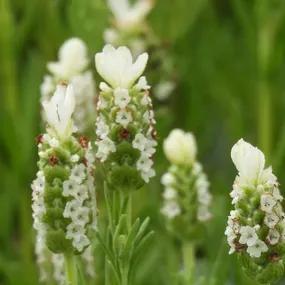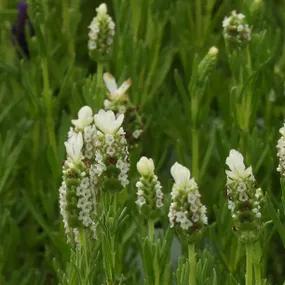Snowman White French Lavender Plants
The details
Lavandula stoechas
- Early Flowering
- Colour: Pure white flowerheads & ears
- Height: 35-45m
- Scent: Strong lavender scent
- Flowering: May to July/August
- Evergreen, grey-green aromatic foliage
- Drought resistant, grows on the coast
- Attractive to bees and butterflies
Recommended extras
Description
Lavandula stoechas Snowman, French Lavender Plants
Snowman, bonhomme de neige at home, is the white French lavender. The ears on top emerge first, while the green buds below are still green, and then the white florets open in vertical lines until the whole thing looks like its namesake. Great for bees & butterflies.
The grey-green evergreen foliage is strongly scented, and they are one of our smallest lavender varieties at only 45cm tall when in full flower.
French lavender blooms earlier than its "English" angustifolia relatives, sometimes starting in May: if you deadhead it a little, you can extend its flowering into August, but June & July are its peak season.
Features
- Colour: Pure white flowerheads & ears
- Height: 35-45m
- Scent: Strong lavender scent
- Flowering: May to July/August
- Evergreen, grey-green aromatic foliage
- Drought resistant, grows on the coast
- Attractive to bees and butterflies
Growing French Lavender
The RHS give it a hardiness rating of H4, the most tricky rating, meaning it will withstand an "average winter" down to around -5C without much damage.
Ideally, it wants a sheltered, sunny spot against a south-facing wall in most of the country outside the South West. In colder inland and Northern regions, we recommend growing it in pots that can either be moved into shelter in winter, or that receive heat from the house and can be covered up to make a cosy microclimate. For protection in the garden, horticultural fleece is good for rows, and buckets with ventilation holes in them, or large pots, should work for covering single plants.
Plant in sharply drained soil and full sun. If your soil’s heavy, dig in lots of grit and make a ridge or raised bed, or save yourself the trouble and grow it in pots.
Prune immediately after flowering.
Did you know?
This variety's name is a pinnacle of taxonomic achievement, worth every penny of public funding: Lavandula stoechas subsp. stoechas f. leucantha Snowman.
Planting Instructions
How to plant French lavender
Choose a sheltered spot with as much light as possible. Improve the soil from the hole by removing roots, weeds, large stones and other rubbish and mixing in plenty of sharp sand or grit.
Position your lavender so its roots are spread out.
Then backfill the hole with mixed soil and grit/sharp sand, firming it gently as you go. Water in thoroughly.
Deadhead. Prune in late summer, and again in early spring if necessary. Avoid cutting into woody stems.



